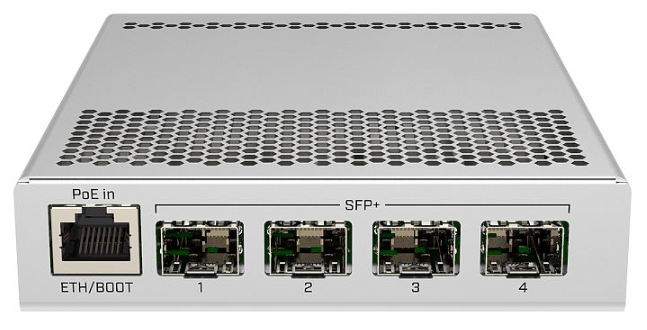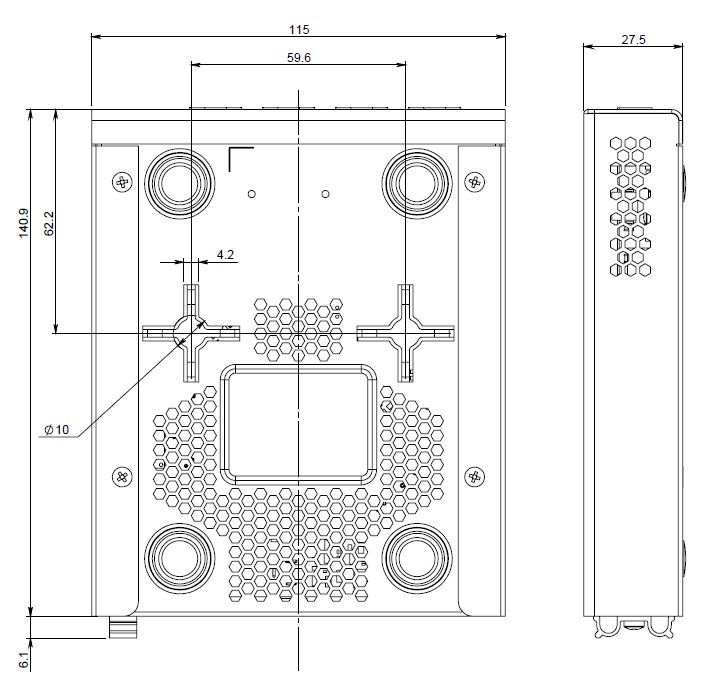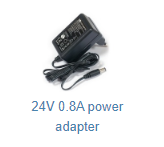CRS305-1G-4S+IN
This device is a 10 Gigabit SFP+ switch, powered by RouterOS. It features two redundant DC inputs. The device has four SFP+ cages (modules are not included) for high-performance 10GbE connectivity (1.25 Gbit modules are also supported) and a 1GbE copper port for management. The device is ready to use as a switch.
Safety Warnings
Before you work on any equipment, be aware of the hazards involved with electrical circuitry, and be familiar with standard practices for preventing accidents.
Ultimate disposal of this product should be handled according to all national laws and regulations.
The Installation of the equipment must comply with local and national electrical codes.
This unit is intended to be installed in the rackmount. Please read the mounting instructions carefully before beginning installation. Failure to use the correct hardware or to follow the correct procedures could result in a hazardous situation to people and damage to the system.
This product is intended to be installed indoors. Keep this product away from water, fire, humidity or hot environments.
Use only the power supply and accessories approved by the manufacturer, and which can be found in the original packaging of this product.
Read the installation instructions before connecting the system to the power source.
We cannot guarantee that no accidents or damage will occur due to the improper use of the device. Please use this product with care and operate at your own risk!
In the case of device failure, please disconnect it from power. The fastest way to do so is by unplugging the power plug from the power outlet.
It is the customer's responsibility to follow local country regulations, including operation within legal frequency channels, output power, cabling requirements, and Dynamic Frequency Selection (DFS) requirements. All Mikrotik devices must be professionally installed.
Quickstart
The default configuration is Switch:
*all interfaces switched;
LAN configuration.
The Default configuration, Switch mode all interfaces are switched; LAN Configuration.
All ports bridged with IP 192.168.88.1/24 set on the bridge.
- Place on the flat surface (see “Mounting”).
- Connect your PC to any Ethernet port.
- Connect the power adapter to the DC jack.
- Set IP for you PC to 192.168.88.2
- The Initial connection has to be done via the Ethernet cable, using the MikroTik Winbox utility or Web
browser. - Use Winbox or Web browser to connect to the default IP address of 192.168.88.1 from any port, with the
username admin and no password. - We recommend clicking the “Check for updates” button and updating your RouterOS software to the latest
version to ensure the best performance and stability. The device needs to have an active internet
connection. - To manually update the device go to our webpage and download the latest software version packages.
- Open Winbox and upload them to the Files menu.
- Reboot the device.
- Set up your password to secure the device.
https://wiki.mikrotik.com/wiki/SwOS/CRS3xx#Connecting_to_the_Switch
Mounting
This device is designed for use indoors by placing it on the flat surface or mounting on the wall when mounting on the wall, please ensure that cable feed is pointing downwards. We recommend using Cat5/6 shielded cable for our devices. The distance measured in mm.
Powering
The device accepts powering from the two DC power jacks (redundancy fail-over) or from the first Ethernet port:
- Direct input power jacks DC1, DC2 (5.5 mm outside and 2 mm inside, female, pin positive) accept DC ⎓ 12-57 V DC.
- The first Ethernet port accepts passive or 802.3af/at Power over Ethernet in the range of DC ⎓ 12-57 V.
The power consumption of this device under maximum load with fiber SFP modules is 10 W when using all RJ10 copper modules, up to 18 W.
When using 802.3af/at to power this device, we recommend not using grounding for best compatibility.
Connecting to a POE Adapter:
- Connect the Ethernet cable from the device to the POE port of the POE adapter.
- Connect an Ethernet cable from your LAN to the LAN port of the POE adapter, please mind arrows for data and power flow.
- Connect the power cord to the adapter, and then plug the power cord into a power outlet.
Booting process
The device supports booting RouterOS (for complete routing and switching configuration) or SwOS (for only using as a switch). By default, the device will boot RouterOS, but you can reboot into SwOS in the following ways:
- From SwOS: In the System menu, click the "Boot RouterOS" button on the bottom of the page.
- From RouterOS: in the System, RouterBOARD menu, click "Settings" and there select "Boot OS".
Configuration
RouterOS includes many configuration options in addition to what is described in this document. We suggest starting here to get yourself accustomed to the possibilities: https://wiki.mikrotik.com/wiki/Manual:CRS3xx_series_switches.
The Initial connection has to be done via the Ethernet cable, using the MikroTik Winbox utility. Winbox should be used to connect to the default IP address of 192.168.88.1 from any port, with the username admin and no password.
For recovery purposes, it is possible to reinstall the device from the network, see the Reset button.
In case the IP connection is not available, the Winbox tool (https://mt.lv/winbox![]() ) can also be used to connect to the MAC address of the device. Applies only when the device has booted RouterOS.
) can also be used to connect to the MAC address of the device. Applies only when the device has booted RouterOS.
Extension Slots and Ports
- Four SFP+ cages, which accept both 1.25 Gb SFP and 10 Gb SFP+ modules.
- One Gigabit Ethernet port, suggested to be used for management (Supports Auto MDI/X so you can use either straight or cross-over cables for connecting to other network devices). The Ethernet port (ETH/BOOT) can also be used for network booting and recovery with Netinstall.
Reset button
To use the reset button, hold it and then turn on the device, while still holding the button.
- Release the button when green LED starts flashing, to reset RouterOS configuration. To not load backup bootloader, you can start holding the button after power is already applied.
- Release the button after LED is no longer flashing (~20 seconds) to cause the device to look for Netinstall servers (required for reinstalling RouterOS over the network). You can also release the button at the time when the device has appeared in the Netinstall utility device list.
Regardless of the above option used, the system will load the backup RouterBOOT loader if the button is pressed before power is applied to the device. Useful for RouterBOOT debugging and recovery.
Accessories
Package includes the following accessories that come with the device:
Please visit wiki pages for MikroTik SFP module compatibility table: https://wiki.mikrotik.com/wiki/MikroTik_SFP_module_compatibility_table
Operating system support
The device supports dual boot SwOS software version 2.9 and RouterOS v6. The specific factory-installed version number is indicated in the RouterOS menu /system resource. Other operating systems have not been tested.
https://wiki.mikrotik.com/wiki/SwOS/CRS3xx
To avoid pollution of the environment, please separate the device from household waste and dispose of it in a safe manner, such as in designated waste disposal sites. Familiarize yourself with the procedures for the proper transportation of the equipment to the designated disposal sites in your area.
Federal Communication Commission Interference Statement
This equipment has been tested and found to comply with the limits for a Class B digital device, pursuant to Part 15 of the FCC Rules. These limits are designed to provide reasonable protection against harmful interference in a residential installation.
This equipment generates, uses, and can radiate radio frequency energy and, if not installed and used in accordance with the instructions, may cause harmful interference to radio communications. However, there is no guarantee that interference will not occur in a particular installation. If this equipment does cause harmful interference to radio or television reception, which can be determined by turning the equipment off and on, the user is encouraged to try to correct the interference by one or more of the following measures:
- Reorient or relocate the receiving antenna.
- Increase the separation between the equipment and receiver.
- Connect the equipment into an outlet on a circuit different from that to which the receiver is connected.
- Consult the dealer or an experienced radio/TV technician for help.
FCC Caution: Any changes or modifications not expressly approved by the party responsible for compliance could void the user's authority to operate this equipment.
This device complies with Part 15 of the FCC Rules. Operation is subject to the following two conditions: (1) This device may not cause harmful interference, and (2) this device must accept any interference received, including interference that may cause undesired operation.
Note: This unit was tested with shielded cables on the peripheral devices. Shielded cables must be used with the unit to ensure compliance.
Innovation, Science and Economic Development Canada
This device complies with Industry Canada's license-exempt RSS standard(s). Operation is subject to the following two conditions: (1) this device may not cause interference, and (2) this device must accept any interference, including interference that may cause undesired operation of the device.
Le présent appareil est conforme aux CNR d'Industrie Canada applicables aux appareils radio exempts de licence. L'exploitation est autorisée aux deux conditions suivantes: (1) l'appareil ne doit pas produire de brouillage, et (2) l'utilisateur de l'appareil doit accepter tout brouillage radioélectrique subi, même si le brouillage est susceptible d'en compromettre le fonctionnement.
This Class B digital apparatus complies with Canadian ICES-003.
Cet appareil numérique de la classe [B] est conforme à la norme NMB-003 du Canada.
CAN ICES-003 (B) / NMB-003 (B)
UKCA marking
Eurasian Conformity Mark
Информация о дате изготовления устройства указана в конце серийного номера на его наклейке через дробь. Первая цифра означает номер года (последняя цифра года), две последующие означают номер недели.
Изготовитель: Mikrotikls SIA, Aizkraukles iela 23, Riga, LV-1006, Латвия, support@mikrotik.com. Сделано в Китае, Латвии или Литве. Cм. на упаковке.
Для получения подробных сведений о гарантийном обслуживании обратитесь к продавцу. Информация об импортерах продукции MikroTik в Российскую Федерацию: https://mikrotik.com/buy/europe/russia
Продукты MikroTik, которые поставляются в Евразийский таможенный союз, оцениваются с учетом соответствующих требований и помечены знаком EAC, как показано ниже:
Norma Oficial Mexicana
EFICIENCIA ENERGETICA CUMPLE CON LA NOM-029-ENER-2017.
La operacion de este equipo esta sujeta a las siguientes dos condiciones:
- Es posible que este equipo o dispositivo no cause interferencia perjudicial y.
- Este equipo debe aceptar cualquier interferencia, incluyendo la que pueda causar su operacion no deseada.
Fabricante: Mikrotikls SIA, Brivibas gatve 214i, Riga, LV-1039, Latvia.
País De Origen: Letonia; Lituania; China (Republica Popular); Estados Unidos De America; Mexico.
Por favor contacte a su distribuidor local para preguntas regionales específicas. La lista de importadores se puede encontrar en nuestra página de inicio – https://mikrotik.com/buy/latinamerica/mexico.
CE Declaration of Conformity
Manufacturer: Mikrotikls SIA, Brivibas gatve 214i Riga, Latvia, LV1039.
The full text of the EU Declaration of Conformity is available at the following internet address: https://mikrotik.com/products





